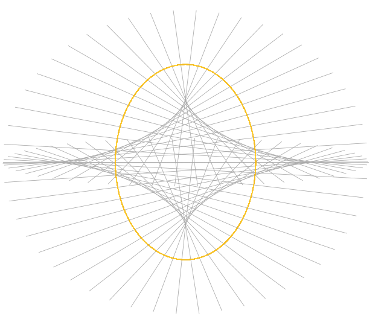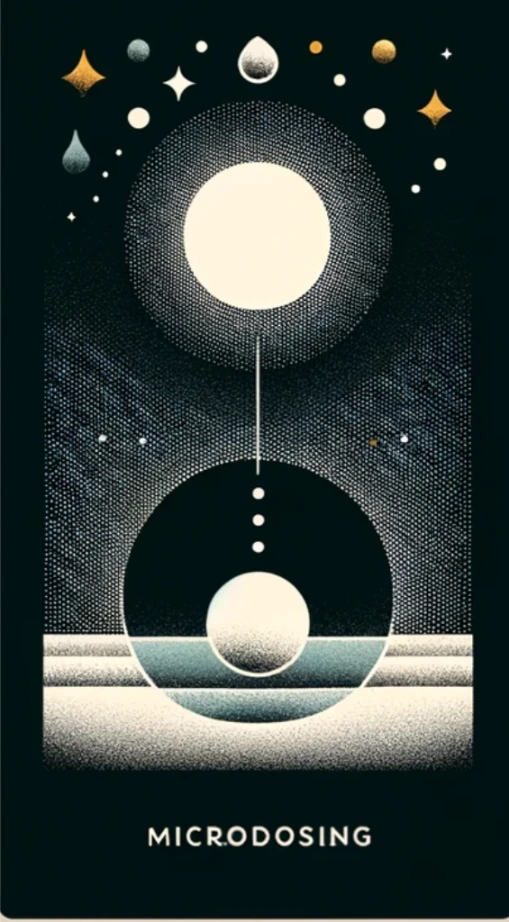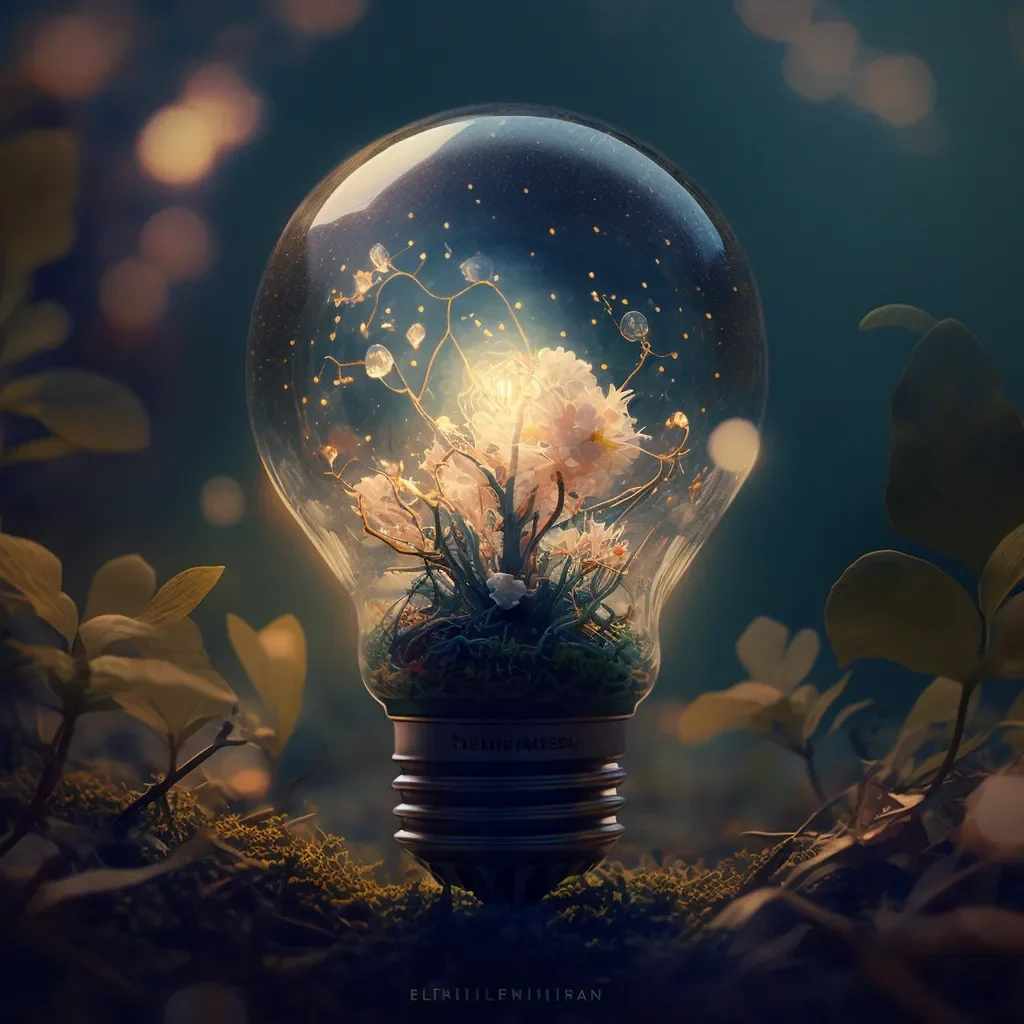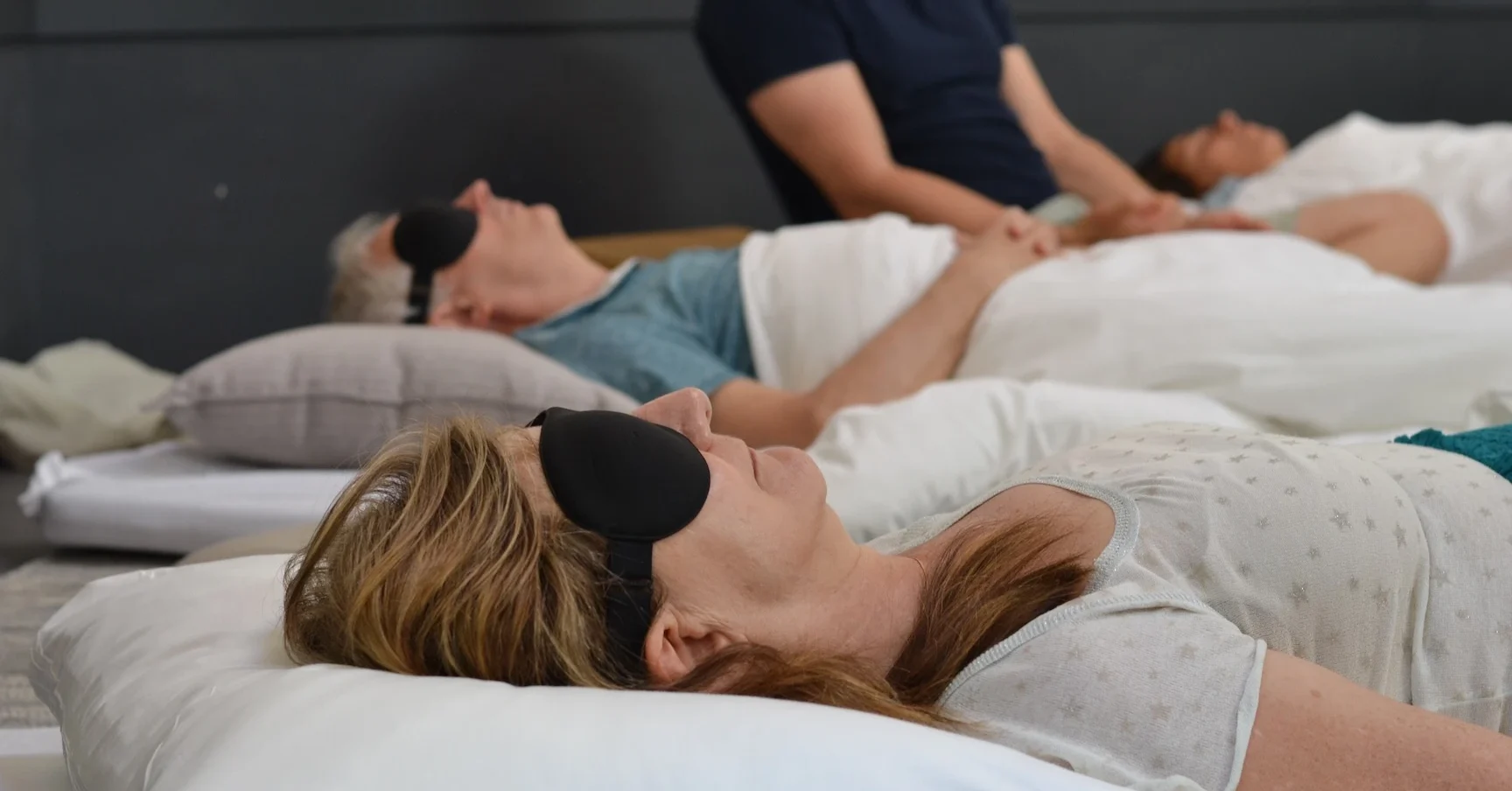Dmitrij Achelrod PhD
Contributing Authors
Nino Galvez Leferink | Feature image by Mikael Kristenson
Dmitrij Achelrod PhD
Contributing Authors
Nino Galvez Leferink | Feature image by Mikael Kristenson
The field of personal development has witnessed the advent of psychedelic substances as tools for transformation. Grounded in scientific research, psychedelics have demonstrated substantial effects on the brain and have been linked with benefits for mental well-being and spiritual enrichment, particularly in the context of high-dose experiences to improve mental health.
However, more and more people find it impractical to regularly indulge in high-dose psilocybin journeys or sometimes are worried about the intensity of such high-dose journeys. Instead, they try to include regular dosing of psychedelics, such as psilocybin or LSD, in much smaller quantities in their daily lives. This practice is called psychedelic microdosing.
Microdosing and macrodosing are two such modalities that offer distinctive paths to self-development and self-discovery, each utilizing a varying dose and context to our path of personal growth. This article delves into the potential of both microdosing and macrodosing for personal growth, comparing its benefits and downsides. It took us weeks to write this article and to review the available evidence on microdosing and macrodosing so that you don’t have to. We hope it enlightens your path forward.
1. What is microdosing?
Microdosing involves taking “micro” or very small, sub-perceptual quantities of substances such as LSD or psilocybin. The doses are typically a small fraction of a full-dose that would be used in macrodosing Usually, we are talking about 1/5 down to 1/20 of a macro dose. Proponents of this method claim it enhances mood, productivity, mindfulness, creativity, and cognition without significant perceptual alterations or psychedelic experiences. As the article “How Silicon Valley rediscovered LSD”[1] shows, microdosing is heralded by creative minds and corporate leaders for its propensity to cultivate out-of-the-box thinking and heightened productivity, thereby transcending the bounds of personal development to touch upon professional excellence.
The recent surge in popularity of microdosing has its roots in James Fadiman’s 2011 book, “The Psychedelic Explorers Guide.”[2] This publication brought the concept of microdosing into the mainstream, sparking a wave of personal accounts, media coverage, and scientific studies on the topic. One of the most popular accounts of the positive impacts of microdosing is Ayelet Waldman’s book “A Really Good Day”.[3] Ayelet Waldman, a successful public federal defender, struggled with deep depression beneath her outward success. Inspired by James Fadiman’s work on microdosing, she decided to try it herself and experienced a profound transformation. For the first time, she felt that something helps against her depression. She overcame her mood swings and gained newfound confidence. This journey not only altered her mental health but also fundamentally changed her perspective on life.
2. Summing up the scientific evidence
While all those individual reports about the positive effects of microdosing sound alluring, the question is if those anecdotal claims of microdosing really can be substantiated?
What is clear is that the scientific evaluation of microdosing benefits is still in its nascent stages. Unfortunately, the answer isn’t clear-cut if microdosing is really effective. While certain research suggests tangible benefits from microdosing, other studies offer less compelling evidence, showing minimal or no advantages. For instance, a recent observational study involving almost 1000 individuals microdosing psilocybin and almost 200 non-microdosing participants over a month revealed modest enhancements in mood and mental health, consistent across various demographics and mental health statuses.[4] Such findings align with numerous personal accounts praising microdosing’s positive impacts.
However, not all research on microdosing yields such positive results. A notable study employed a randomized controlled trial, the gold standard for eliminating placebo effects, involving 34 participants.[5] They were divided, with half receiving psilocybin and the other half a placebo. Despite some subjective improvements in happiness and creativity, and even alterations in EEG-recorded brain activity, the study found no concrete evidence of enhanced creativity, well-being, or cognitive function with low-dose psilocybin. This research supports the theory that the benefits perceived from microdosing at these lower levels might largely stem from expectation[6], suggesting that higher doses might be necessary for therapeutic effects.
The most comprehensive review study on microdosing, so far, was conducted by Polito et al. in 2022. After reviewing 44 studies, some of which were published back in the 1960’s, the authors came to the following conclusion: There is good evidence that psychedelic microdosing can lower pain perception[7], and influence subjective awareness. Improvements in mental health, substance use disorders, and psychological functioning could not be confidently substantiated.[8]
The summary of their findings is shown in the following table, separated by study type.
| Observed Effects from Both Self-Reports and Laboratory Studies | Reported Effects in Self-Reports but Insufficiently Explored in Labs | Reported Effects in Self-Reports, but not Confirmed in Lab Settings |
|---|---|---|
| Altered perception of time | Enhanced mental health | Elevation in mood |
| Increased pain threshold | Decrease in drug use | Strengthened social bonds |
| Shifts in conscious state | Greater uptake | Improved mental processes |
| Descreased mind wandering | Increased emotional awareness | |
| Shifts in personality traits | Improved energy | |
| Increased psychological insight | ||
| Connection with nature | ||
| General wellbeing | ||
| Inceased creative thinking |
3. How can I benefit from microdosing?
Mood and Mental Health
Microdosing has been commonly associated with improved mood in various qualitative, retrospective, prospective, and laboratory studies[9], [10]. It has also been linked with lower depression scores, although some studies, especially well-controlled laboratory ones, did not find significant changes in depression, negative affect, or positive affect scores on dosing days.[11], The impact on anxiety and stress showed mixed results, with some studies reporting decreases and others increases or mixed outcomes.[11], [12] Substance misuse improvements were reported, particularly in qualitative studies, with microdosing linked to reductions in smoking and substance use. However, these effects have not been widely investigated in laboratory settings.[6] Moreover, some studies associated microdosing with improved general mental health and reduced OCD severity. [7], [9]–[26]
Wellbeing and Attitudes
Increases in wellbeing, self-fulfilment, self-efficacy, and resilience were reported in three qualitative and one retrospective survey study. However, no laboratory-based studies have investigated these aspects yet. [6], [8], [15], [27]
Creativity and Cognition
Several studies indicated that microdosing may be associated with increases in creativity[28], with reports of enhanced convergent and divergent thinking. However, findings were not consistent across all studies. Some studies showed changes in neurocognitive behavioural tasks, such as impacts on time perception and selective attention, but again, results varied, with some studies reporting no significant effects.[13]–[15], [16], [18], [21], [22], [29]–[31]
Personality
Reports on personality changes due to microdosing were less consistent. Some studies reported increases in traits like openness and extraversion, while others did not find significant changes in the classic big five personality traits. Notably, most experiments focused on acute rather than long-term changes, limiting insights into lasting personality alterations. Studies consistently reported increases in interpersonal feelings, attitudes, and behaviors, indicating improved relationships and interpersonal connections. [6], [9], [12], [18], [21], [22], [27], [32]–[34]
Changes in Conscious State
Despite claims that microdosing is sub-perceptual, evidence suggests that it leads to changes in subjective awareness. A qualitative analysis indicated changes in psychophysiological state, characterized by heightened presence and perceptual clarity, believed to be essential for the beneficial effects of microdosing. [18], [20], [22], [22], [30], [35]–[42]
Summing up, initial studies point to potential advantages; however, the scientific community pleads for more high-quality research to substantiate these findings.
4. Is microdosing safe?
– The hidden dangers of microdosing
We do not have enough evidence about risks related to long-term use. But one of the biggest concerns is that prolonged use of psilocybin in microdosing might cause valvular heart disease because of the chronic activation of serotonin 2B receptors.[43]
Valvular heart disease (VHD) involves the impairment of heart valves responsible for managing blood circulation in and out of the heart, leading to symptoms like breathlessness, general weakness, and even the risk of sudden heart-related death. Medications that strongly interact with the serotonin 2B receptor (5HT2B) have been implicated as a potential cause for VHD. For example, up to one quarter of chronic users of the common prescription medications methylergonovine, methysergide, ergotamine, pergolide, cabergoline, and fenfluramine develop VHD. This is most likely because these drugs exhibit a marked 5HT2B receptor binding affinity.[44] Because LSD and psilocybin are known for their binding to the 5HT2B receptor, this might be concerning when these substances are used in small, consistent doses over long periods.
In a study involving 29 MDMA users who took an average of 3.6 MDMA pills weekly for over half a decade, almost one third were found to have mild to moderate VHD. This was a notable contrast to a control group, where no instances of VHD were reported.[45] This study signals a concerning trend, as LSD and psilocybin, commonly used in microdosing, bind more strongly to the 5HT2B receptor than MDMA. It is very clear that more research on the safety of microdosing is needed before it can be considered safe.
Another downside of microdosing might be the tolerance the body builds to these substances, making them ineffective if not followed in a structured regimen where the intake is paused. Tolerance seems to be gained more quickly with LSD than with psilocybin.[46]
5. Macrodosing Psychedelics in a Retreat Context
Macrodosing, on the other hand, involves consuming a large or ‘macro’ dose of a psychedelic substance. An approach best undertaken within a safe, legal and well-guided retreat setting. To learn about how to pick a well-facilitated psychedelic retreat that suits you, see this article.
A well-guided macrodose experience induces a powerful experience characterized by significant alterations in perception, mood, and cognitive processes. Often this experience is described, like pioneering researcher Prof. Roland Griffiths did, as “ineffable”, meaning that one can not put words to the experience. Study participants described their macrodosing journey as one of the most profound experiences in their lives, comparing them to the birth of their children or the death of a close relative or loved one.[47] If you are still curious, you can find our attempt to describe it here. A macro dose, in an ideal environment, can create a deeply meaningful, insightful, introspective experience that, when integrated effectively, can forge persistent beneficial impacts on an individual’s self-understanding, emotional wellbeing, outlook on life and spiritual growth.[47] The benefits of a macro dose psychedelic experience do not depend on continually taking the substance. On the contrary, many people report that one macrodose psychedelic experience has been so significant that it has shown them enough for them to integrate and take action on for years.
In stark contrast to microdosing, there is a substantial body of scientific evidence showing that macrodosing (particularly with psilocybin) is, under the right conditions (!), a safe practice [48]–[51] and can have positive effects in ill and healthy populations on a wide range of factors, ranging from psychological dimensions like mood, over spiritual well-being to physiological changes like increased neuroplasticity. [52]–[57]
The intensity of macrodosing can be overwhelming, potentially leading to temporary psychological discomfort. Therefore, professional guidance within a supportive setting is highly recommended to ensure safety and maximize the benefits of the experience. Participants should always be screened for certain preexisting psychiatric disorders, for their psychological stability and for other factors (e.g. medical history, medication intake…) by qualified medical professionals before engaging in a macrodose journey. Otherwise, a macrodose journey can do more harm than good and destabilize people.
Substances commonly used for macrodosing in retreat contexts are the “classic psychedelics” which include psilocybin (magic mushrooms), LSD, DMT (ayahuasca), and mescaline (peyote and San Pedro cacti), selected on their psychoactive profile and the desired duration and depth of the experience.
Something in between the micro dose and the macro dose
In our article titled “A peek into the psychedelic mind”, we describe how the relationship between the dose one takes and what one experiences, can be compared to a dial. As you turn the dial up, by taking a higher dose, the experience becomes more intense and the person influenced becomes more vulnerable. So yes, there is a lot in between a micro dose and a macro dose.
We believe that the appeal of a microdose is that there is no risk for a so-called “bad trip”, because there are no perceptual effects or drastic changes in consciousness. It can be used more casually, in day-to-day life, and it is more affordable than a well-facilitated retreat. However, microdosing will never be able to provide one the depth of experience and potential for transformation that one can have when undergoing a macrodose psychedelic experience. It is normal to fear such an experience more, because we don’t want a bad experience and we don’t know who we will be after the macrodose journey ends.
Before stepping into the unknown of a macro psychedelic experience, it is a normal and healthy sign to experience excitement and slight nervousness. Through proper preparation, guidance and being in the right setting, one can learn to trust and to surrender and let go into the experience. That is the key to prevent a “bad trip” from happening (besides ensuring medical eligibility, of course). If you are curious to learn more about bad trips, what causes them and how to prevent them, have a look at this article.
What dosage do we use in our psychedelic retreat programs?
In our psychedelic retreat programs EvoLEAD and EvoCORE, the on-site facilitation team consisting of medical doctors, clinical psychologists, and ceremonial facilitators carefully decides on a personally-tailored dose of psychedelic truffles for each participant. We do not work with microdoses, since we craft a safe container for a deeper experience. The dosage each participant receives is partly determined by the results of the medical-psychological screening, but also by keeping in mind what the retreat participant wants to discover and what she is ready for. Lastly, it is also based on how the participant responds to the holotropic-style breathwork which we usually do on Day 1 of the retreats (holotropic breathwork helps to get to know altered states of consciousness already and serves as a preparation for the psilocybin-containing truffle experience on the next day).
7. Conclusion: Microdosing vs. Macrodosing
As we have seen, microdosing and macrodosing serve different and potentially complementary pathways to personal growth and development. However, the depth to which they have impact on our lives is very different.
Microdosing is often the regimen of choice for those seeking to subtly enhance daily life, such as having gentle creative boosts. The scientific evidence on the benefits of microdosing is not strong and warrants further investigations. There might be safety issues when microdosing psychedelics over prolonged periods of time.
On the other hand, macrodosing, particularly in the context of a well-facilitated psychedelic retreat, is sought after for its capacity to facilitate profound introspection, transformational psychological development and/or integration (“healing“), without the need for continuous use. The scientific evidence on the safety and effectiveness of macrodosed psychedelics (particularly psilocybin) is strong.
As a final note: no matter in which way you engage with a psychedelic substance, but especially as the dose goes up, the importance of the right preparation, framing, guidance, setting, understanding and support cannot be emphasized enough to ensure a beneficial and safe experience. Have a look at our article HOW TO PICK A PSYCHEDELIC RETREAT THAT RESONATES WITH YOUR PERSONAL VALUES AND BELIEFS to get a better feeling for what to look out for when considering a psychedelic retreat provider.
Please bear in mind that we do not provide medical advise and you should always seek assistance from a medical professional before making any decision about consuming psychedelics.
Bibliography on Microdosing
[1] H. Kuchler, “How Silicon Valley rediscovered LSD,” Financial Times, Aug. 10, 2017. Accessed: Nov. 27, 2023. [Online]. Available: https://www.ft.com/content/0a5a4404-7c8e-11e7-ab01-a13271d1ee9c
[2] “The Psychedelic Explorer’s Guide | Dr. James Fadiman’s manual offers helpful and well-informed guidance for those who seek ‘the divine within’ through sacred plants and psychedelic substances.” Accessed: Nov. 27, 2023. [Online]. Available: https://www.psychedelicexplorersguide.com/
[3] “A Really Good Day by Ayelet Waldman: 9781101973721 | PenguinRandomHouse.com: Books,” PenguinRandomhouse.com. Accessed: Nov. 27, 2023. [Online]. Available: https://www.penguinrandomhouse.com/books/545767/a-really-good-day-by-ayelet-waldman/
[4] J. M. Rootman et al., “Psilocybin microdosers demonstrate greater observed improvements in mood and mental health at one month relative to non-microdosing controls,” Sci. Rep., vol. 12, no. 1, Art. no. 1, Jun. 2022, doi: 10.1038/s41598-022-14512-3.
[5] F. Cavanna et al., “Microdosing with psilocybin mushrooms: a double-blind placebo-controlled study,” Transl. Psychiatry, vol. 12, no. 1, Art. no. 1, Aug. 2022, doi: 10.1038/s41398-022-02039-0.
[6] L. S. Kaertner et al., “Positive expectations predict improved mental-health outcomes linked to psychedelic microdosing,” Sci. Rep., vol. 11, no. 1, Art. no. 1, Jan. 2021, doi: 10.1038/s41598-021-81446-7.
[7] J. G. Ramaekers et al., “A low dose of lysergic acid diethylamide decreases pain perception in healthy volunteers,” J. Psychopharmacol. Oxf. Engl., vol. 35, no. 4, pp. 398–405, Apr. 2021, doi: 10.1177/0269881120940937.
[8] V. Polito and P. Liknaitzky, “The emerging science of microdosing: A systematic review of research on low dose psychedelics (1955–2021) and recommendations for the field,” Neurosci. Biobehav. Rev., vol. 139, p. 104706, Aug. 2022, doi: 10.1016/j.neubiorev.2022.104706.
[9] “Johnstad, P. G. (2018). Powerful substances in tiny amounts: An interview study of psychedelic microdosing. Nordic Studies on Alcohol and Drugs, 35(1), 39-
[10] “Anderson, T., Petranker, R., Christopher, A., Rosenbaum, D., Weissman, C., Dinh-Williams, L.-A., Hui, K., and Hapke, E. (2019a). Psychedelic microdosing benefits and challenges: an empirical codebook. Harm Reduction Journal, 16(1), 43.”.
[11] L. P. Cameron, C. J. Benson, L. E. Dunlap, and D. E. Olson, “Effects of N, N-Dimethyltryptamine on Rat Behaviors Relevant to Anxiety and Depression,” ACS Chem. Neurosci., vol. 9, no. 7, pp. 1582–1590, Jul. 2018, doi: 10.1021/acschemneuro.8b00134.
[12] “Psilocybin produces substantial and sustained decreases in depression and anxiety in patients with life-threatening cancer: A randomized double-blind trial – Roland R Griffiths, Matthew W Johnson, Michael A Carducci, Annie Umbricht, William A Richards, Brian D Richards, Mary P Cosimano, Margaret A Klinedinst, 2016.” Accessed: Nov. 27, 2023. [Online]. Available: https://journals.sagepub.com/doi/full/10.1177/0269881116675513
[13] J. Fadiman and S. Korb, “Might Microdosing Psychedelics Be Safe and Beneficial? An Initial Exploration,” J. Psychoactive Drugs, vol. 51, no. 2, pp. 118–122, 2019, doi: 10.1080/02791072.2019.1593561.
[14] T. Lea, N. Amada, H. Jungaberle, H. Schecke, and M. Klein, “Microdosing psychedelics: Motivations, subjective effects and harm reduction,” Int. J. Drug Policy, vol. 75, p. 102600, Jan. 2020, doi: 10.1016/j.drugpo.2019.11.008.
[15] M. Webb, H. Copes, and P. S. Hendricks, “Narrative identity, rationality, and microdosing classic psychedelics,” Int. J. Drug Policy, vol. 70, pp. 33–39, Aug. 2019, doi: 10.1016/j.drugpo.2019.04.013.
[16] T. Anderson et al., “Microdosing psychedelics: personality, mental health, and creativity differences in microdosers,” Psychopharmacology (Berl.), vol. 236, no. 2, pp. 731–740, Feb. 2019, doi: 10.1007/s00213-018-5106-2.
[17] N. R. P. W. Hutten, N. L. Mason, P. C. Dolder, and K. P. C. Kuypers, “Motives and Side-Effects of Microdosing With Psychedelics Among Users,” Int. J. Neuropsychopharmacol., vol. 22, no. 7, pp. 426–434, Jul. 2019, doi: 10.1093/ijnp/pyz029.
[18] B. Szigeti et al., “Self-blinding citizen science to explore psychedelic microdosing,” eLife, vol. 10, p. e62878, Mar. 2021, doi: 10.7554/eLife.62878.
[19] N. R. P. W. Hutten et al., “Mood and cognition after administration of low LSD doses in healthy volunteers: A placebo controlled dose-effect finding study,” Eur. Neuropsychopharmacol. J. Eur. Coll. Neuropsychopharmacol., vol. 41, pp. 81–91, Dec. 2020, doi: 10.1016/j.euroneuro.2020.10.002.
[20] H. Isbell, “Comparison of the reactions induced by psilocybin and LSD-25 in man,” Psychopharmacologia, vol. 1, pp. 29–38, 1959, doi: 10.1007/BF00408109.
[21] V. Polito and R. J. Stevenson, “A systematic study of microdosing psychedelics,” PLOS ONE, vol. 14, no. 2, p. e0211023, Feb. 2019, doi: 10.1371/journal.pone.0211023.
[22] A. K. Bershad, S. T. Schepers, M. P. Bremmer, R. Lee, and H. de Wit, “Acute Subjective and Behavioral Effects of Microdoses of Lysergic Acid Diethylamide in Healthy Human Volunteers,” Biol. Psychiatry, vol. 86, no. 10, pp. 792–800, Nov. 2019, doi: 10.1016/j.biopsych.2019.05.019.
[23] A. K. Bershad et al., “Preliminary Report on the Effects of a Low Dose of LSD on Resting-State Amygdala Functional Connectivity,” Biol. Psychiatry Cogn. Neurosci. Neuroimaging, vol. 5, no. 4, pp. 461–467, Apr. 2020, doi: 10.1016/j.bpsc.2019.12.007.
[24] A. Kjellgren, A. Eriksson, and T. Norlander, “Experiences of Encounters with Ayahuasca—‘the Vine of the Soul,’” J. Psychoactive Drugs, vol. 41, no. 4, pp. 309–315, Dec. 2009, doi: 10.1080/02791072.2009.10399767.
[25] P. Gasser, K. Kirchner, and T. Passie, “LSD-assisted psychotherapy for anxiety associated with a life-threatening disease: a qualitative study of acute and sustained subjective effects,” J. Psychopharmacol. Oxf. Engl., vol. 29, no. 1, pp. 57–68, Jan. 2015, doi: 10.1177/0269881114555249.
[26] F. A. Moreno, C. B. Wiegand, E. K. Taitano, and P. L. Delgado, “Safety, tolerability, and efficacy of psilocybin in 9 patients with obsessive-compulsive disorder,” J. Clin. Psychiatry, vol. 67, no. 11, pp. 1735–1740, Nov. 2006, doi: 10.4088/jcp.v67n1110.
[27] T. Anderson et al., “Psychedelic microdosing benefits and challenges: an empirical codebook,” Harm. Reduct. J., vol. 16, no. 1, p. 43, Jul. 2019, doi: 10.1186/s12954-019-0308-4.
[28] J. N. Bonnieux, B. VanderZwaag, Z. Premji, A. Garcia-Romeu, and M. A. Garcia-Barrera, “Psilocybin’s effects on cognition and creativity: A scoping review,” J. Psychopharmacol. (Oxf.), vol. 37, no. 7, pp. 635–648, Jul. 2023, doi: 10.1177/02698811231179801.
[29] L. Prochazkova, D. P. Lippelt, L. S. Colzato, M. Kuchar, Z. Sjoerds, and B. Hommel, “Exploring the effect of microdosing psychedelics on creativity in an open-label natural setting,” Psychopharmacology (Berl.), vol. 235, no. 12, pp. 3401–3413, Dec. 2018, doi: 10.1007/s00213-018-5049-7.
[30] S. Yanakieva, N. Polychroni, N. Family, L. T. J. Williams, D. P. Luke, and D. B. Terhune, “The effects of microdose LSD on time perception: a randomised, double-blind, placebo-controlled trial,” Psychopharmacology (Berl.), vol. 236, no. 4, pp. 1159–1170, Apr. 2019, doi: 10.1007/s00213-018-5119-x.
[31] J. Wackermann, M. Wittmann, F. Hasler, and F. X. Vollenweider, “Effects of varied doses of psilocybin on time interval reproduction in human subjects,” Neurosci. Lett., vol. 435, no. 1, pp. 51–55, Apr. 2008, doi: 10.1016/j.neulet.2008.02.006.
[32] D. Erritzoe et al., “Effects of psilocybin therapy on personality structure,” Acta Psychiatr. Scand., vol. 138, no. 5, pp. 368–378, 2018, doi: 10.1111/acps.12904.
[33] “Imaginary Companions in Childhood: What Can Prospective Longitudinal Research Tell Us About Their Fate by Adolescence?”, doi: 10.1002/jocb.468.
[34] T. GREINER, N. R. BURCH, and R. EDELBERG, “Psychopathology and Psychophysiology of Minimal LSD-25 Dosage: A Preliminary Dosage-Response Spectrum,” AMA Arch. Neurol. Psychiatry, vol. 79, no. 2, pp. 208–210, Feb. 1958, doi: 10.1001/archneurpsyc.1958.02340020088016.
[35] F. Tylš, T. Páleníček, and J. Horáček, “Psilocybin–summary of knowledge and new perspectives,” Eur. Neuropsychopharmacol. J. Eur. Coll. Neuropsychopharmacol., vol. 24, no. 3, pp. 342–356, Mar. 2014, doi: 10.1016/j.euroneuro.2013.12.006.
[36] F. Hasler, U. Grimberg, M. A. Benz, T. Huber, and F. X. Vollenweider, “Acute psychological and physiological effects of psilocybin in healthy humans: a double-blind, placebo-controlled dose–effect study,” Psychopharmacology (Berl.), vol. 172, no. 2, pp. 145–156, Mar. 2004, doi: 10.1007/s00213-003-1640-6.
[37] F. Holze et al., “Distinct acute effects of LSD, MDMA, and D-amphetamine in healthy subjects,” Neuropsychopharmacology, vol. 45, no. 3, Art. no. 3, Feb. 2020, doi: 10.1038/s41386-019-0569-3.
[38] C. C. Wagner and O. Langer, “Approaches using molecular imaging technology – use of PET in clinical microdose studies,” Adv. Drug Deliv. Rev., vol. 63, no. 7, p. 539, Jun. 2011, doi: 10.1016/j.addr.2010.09.011.
[39] R. J. Strassman, C. R. Qualls, E. H. Uhlenhuth, and R. Kellner, “Dose-Response Study of N,N-Dimethyltryptamine in Humans: II. Subjective Effects and Preliminary Results of a New Rating Scale,” Arch. Gen. Psychiatry, vol. 51, no. 2, pp. 98–108, Feb. 1994, doi: 10.1001/archpsyc.1994.03950020022002.
[40] R. R. Griffiths et al., “Psilocybin-occasioned mystical-type experience in combination with meditation and other spiritual practices produces enduring positive changes in psychological functioning and in trait measures of prosocial attitudes and behaviors,” J. Psychopharmacol. (Oxf.), vol. 32, no. 1, pp. 49–69, Jan. 2018, doi: 10.1177/0269881117731279.
[41] E. Studerus, A. Gamma, and F. X. Vollenweider, “Psychometric Evaluation of the Altered States of Consciousness Rating Scale (OAV),” PLOS ONE, vol. 5, no. 8, p. e12412, Aug. 2010, doi: 10.1371/journal.pone.0012412.
[42] R. A. Sewell, J. H. Halpern, and H. G. Pope, “Response of cluster headache to psilocybin and LSD,” Neurology, vol. 66, no. 12, pp. 1920–1922, Jun. 2006, doi: 10.1212/01.wnl.0000219761.05466.43.
[43] “Serotonin receptors and heart valve disease—It was meant 2B – ScienceDirect.” Accessed: Nov. 27, 2023. [Online]. Available: https://www.sciencedirect.com/science/article/abs/pii/S016372581100074X?via%3Dihub
[44] T. Papoian et al., “Regulatory Forum Review*: Utility of in Vitro Secondary Pharmacology Data to Assess Risk of Drug-induced Valvular Heart Disease in Humans: Regulatory Considerations,” Toxicol. Pathol., vol. 45, no. 3, pp. 381–388, Apr. 2017, doi: 10.1177/0192623317690609.
[45] S. Droogmans et al., “Possible association between 3,4-methylenedioxymethamphetamine abuse and valvular heart disease,” Am. J. Cardiol., vol. 100, no. 9, pp. 1442–1445, Nov. 2007, doi: 10.1016/j.amjcard.2007.06.045.
[46] S. Baumann, R. Carhart-Harris, D. Nutt, D. Erritzoe, and B. Szigeti, “Evidence for tolerance in psychedelic microdosing from the self-blinding microdose trial.” PsyArXiv, Oct. 19, 2022. doi: 10.31234/osf.io/s4qhf.
[47] R. R. Griffiths, W. A. Richards, U. McCann, and R. Jesse, “Psilocybin can occasion mystical-type experiences having substantial and sustained personal meaning and spiritual significance,” Psychopharmacology (Berl.), vol. 187, no. 3, pp. 268–283, Aug. 2006, doi: 10.1007/s00213-006-0457-5.
[48] A. T. Hodge, S. Sukpraprut-Braaten, M. Narlesky, and R. C. Strayhan, “The Use of Psilocybin in the Treatment of Psychiatric Disorders with Attention to Relative Safety Profile: A Systematic Review,” J. Psychoactive Drugs, vol. 55, no. 1, pp. 40–50, Jan. 2023, doi: 10.1080/02791072.2022.2044096.
[49] S. Dodd et al., “Psilocybin in neuropsychiatry: a review of its pharmacology, safety, and efficacy,” CNS Spectr., vol. 28, no. 4, pp. 416–426, Aug. 2023, doi: 10.1017/S1092852922000888.
[50] P. Sharma et al., “Psilocybin history, action and reaction: A narrative clinical review,” J. Psychopharmacol. (Oxf.), vol. 37, no. 9, pp. 849–865, Sep. 2023, doi: 10.1177/02698811231190858.
[51] D. Kaminski and J. P. Reinert, “The Tolerability and Safety of Psilocybin in Psychiatric and Substance-Dependence Conditions: A Systematic Review,” Ann. Pharmacother., p. 10600280231205645, Oct. 2023, doi: 10.1177/10600280231205645.
[52] D. B. Goel and S. Zilate, “Potential Therapeutic Effects of Psilocybin: A Systematic Review,” Cureus, vol. 14, no. 10, p. e30214, doi: 10.7759/cureus.30214.
[53] J. van Amsterdam and W. van den Brink, “The therapeutic potential of psilocybin: a systematic review,” Expert Opin. Drug Saf., vol. 21, no. 6, pp. 833–840, Jun. 2022, doi: 10.1080/14740338.2022.2047929.
[54] S. Shnayder, R. Ameli, N. Sinaii, A. Berger, and M. Agrawal, “Psilocybin-assisted therapy improves psycho-social-spiritual well-being in cancer patients,” J. Affect. Disord., vol. 323, pp. 592–597, Feb. 2023, doi: 10.1016/j.jad.2022.11.046.
[55] K. M. Baker, C. M. Ulrich, and S. H. Meghani, “An Integrative Review of Measures of Spirituality in Experimental Studies of Psilocybin in Serious Illness Populations,” Am. J. Hosp. Palliat. Med., vol. 40, no. 11, pp. 1261–1270, Nov. 2023, doi: 10.1177/10499091221147700.
[56] E. Whinkin, M. Opalka, C. Watters, A. Jaffe, and S. Aggarwal, “Psilocybin in Palliative Care: An Update,” Curr. Geriatr. Rep., vol. 12, no. 2, pp. 50–59, Jun. 2023, doi: 10.1007/s13670-023-00383-7.
[57] R. Nardou et al., “Psychedelics reopen the social reward learning critical period,” Nature, vol. 618, no. 7966, Art. no. 7966, Jun. 2023, doi: 10.1038/s41586-023-06204-3.

Dr. Dmitrij Achelrod,
Co-Founder Evolute Institute
Feeling inspired?
LET'S talk
We invite you to schedule a call with us. Together, we can delve into any questions you might have. We can explore whether one of our retreat programs is right for you at this time.






